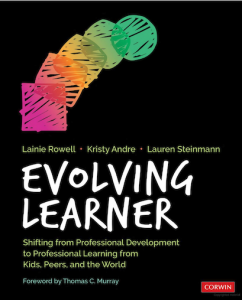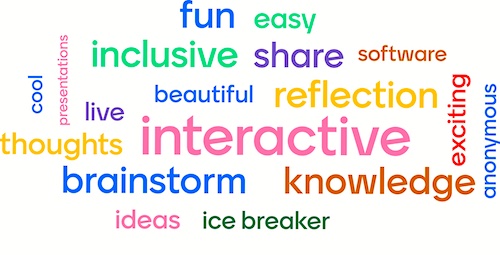Take a moment to look at the image here. Which classroom most represents the way that you learned in school?
Now, which instructional design is the one in which your students would most like to learn?
Because of the Coronavirus, many educators have experienced another instructional setting in recent months:
Can school look more interconnected – like the learner-driven image at the right, above – even when we’re teaching remotely? Author-educators Lainie Rowell, Kristy Andre, and Lauren Steinmann answer that question with a resounding YES!
 In their book Evolving Learner: Shifting From Professional Development to Professional Learning From Kids, Peers, and the World (Corwin 2020) Rowell and her colleagues provide a thorough review of current professional learning research and teaching best practice. They also provide an abundance of tips and simple adaptations that can making teaching and learning more fun and consequential.
In their book Evolving Learner: Shifting From Professional Development to Professional Learning From Kids, Peers, and the World (Corwin 2020) Rowell and her colleagues provide a thorough review of current professional learning research and teaching best practice. They also provide an abundance of tips and simple adaptations that can making teaching and learning more fun and consequential.
I’ve listed a few of my easy-to-do favorites here.
1. Want to start a new unit off with a twist? Use a word cloud.
Use Mentimeter or another app in the classroom —or remotely—and ask students to identify as many words as they can that relate to the topic under study. In the book, the authors point to an important academic and social-emotional learning skill: Relationship Building. Some other tools to create word clouds and similar options are AnswerGarden, WordArt, and MonkeyLearn.
 2. Encourage students to bolster their learning by creating their own quizzes.
2. Encourage students to bolster their learning by creating their own quizzes.
Research shows that students retain more and can apply what they are learning when they self-test and reflect on their own learning. The authors profile a teacher who asks students to create their own quizzes. The result? They learn how to create quality questions and pair them with the correct answers. In the process, she discovered that some of the questions her students developed were actually more rigorous than to ones she had previously used!
3. Create tutorials.
I originally heard this idea from Alan November who suggests that teachers challenge students to identify the most difficult learning problems or concepts in the lesson or unit they are studying. Once identified, the students next develop tutorials to explain the challenging problem.
To see some examples of student-created tutorials, visit mathtrain.tv. Here’s one by 6th grader “Taffy” on finding the missing angle in a triangle. You can create your own classroom YouTube channel or use another platform to post your student-developed video tutorials.
4. My Favorite No.
This is actually an idea gleaned from the Teaching Channel. Called My Favorite No, it begins with presenting students with a challenging problem. Each student individually solves the problem and turns it in. The teacher quickly sorts the responses into piles and selects her favorite mistake. Then, together, the teacher and class analyze the mistake, beginning with a focus on what was right about the response. You can see an example of this process here.
You can also use this strategy when preparing students to write a research paper or essay. Give them an anonymous writing sample on a different topic (drawn from your personal collection of past student work), and have them work in teams to identify the strengths and areas in need of improvement. Engaging students in this way puts them in charge of their own learning.
Share a strategy of your own!
All four of these strategies can work in a brick and mortar classroom or virtually and all shift the cognitive load from the teacher to the student. I know there are many more strategies like the four I’ve listed out there. Please share a favorite or two of your own in the comment box!



0 Comments on "Want to Make Classes More Learner-Driven? Try Four Easy Ideas to Deepen Engagement"